
Alberta, Canada's Banff Summer Arts Festival, set in a mountain range and close to pristine lakes and hot springs, is a tourist attraction, a production facility, an artist and writer's colony, and an educational resource for scholars, professional and business people, elderhostelers, students and visitors from all over the world.
Banff hosts dance, theatre, opera, a film and video festival, multiple classical music, jazz and folk concerts, an Aboriginal Arts Program, a Cultural Journalism exchange, a Paradise Institute installation, where your sense of perceptual balance can be teased out of whack, and a slew of betwixt and betweens.
What Banff does best is support the development of artistic vision: Three creative efforts riveted my attention: Maelstrom (a dance-drama), The Aboriginal Arts Program, and Filumena – a new opera.
Maelstrom
Choreographer Andrew Giday's dynamic interplay of contrasting elements, brought new life to the phrase dance-drama. Using sound and music from the album Weather by Michael Gordon and Lost Objects"from Bang On A Can, Giday created a movement logic all its own. 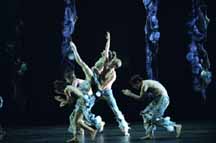 Maelstrom tells a story of a struggle to survive without telling a story. Through abstract imagery, wonderfully charged characters tossing about with an almost heroic will against odds, and elements of mysterious lyricism rising above the whirlpool of sensual dance and action, the work is a harvest of almost molecular expansion and contraction.
Maelstrom tells a story of a struggle to survive without telling a story. Through abstract imagery, wonderfully charged characters tossing about with an almost heroic will against odds, and elements of mysterious lyricism rising above the whirlpool of sensual dance and action, the work is a harvest of almost molecular expansion and contraction.
Maelstrom had the feel of an explosion of primal energy; the dramatic impact of a force of nature. Monoliths rose like distant shadows from the mountains outside. With a flickering suggestion of fetal energy, nude costumed figures struggled into the light under an umbrella of blue – slowly emerging into shape and form. The action expanded and receeded with compelling energy and touches of tender lyricism. Ending with a dancer left behind, collapsed on the floor, like a new born, exhausted.
Next a figure emerged cranking a wind machine – straight out of Dr. Caligari's cabinet - creating bad weather at every turn. Another malovolent techie snapped away at a large tin thunder clap with feverish concentration. Both performers pressing on synergistically. Like two demi-gods having a field day. A thin perpendicular door center stage opened and shut in either direction. 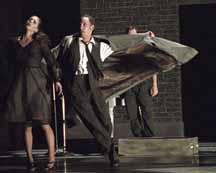 A male dancer, in a Humphrey Bogart overcoat with collar turned up, flipped, twisted, tossed and sailed back and forth a female dancer. Like two crazy star fish looping in a continually shifting tidal wave of wind. The wind chill factor embraced all four struggling figures in a perpetual battle of will to get through the door one way or another.
A male dancer, in a Humphrey Bogart overcoat with collar turned up, flipped, twisted, tossed and sailed back and forth a female dancer. Like two crazy star fish looping in a continually shifting tidal wave of wind. The wind chill factor embraced all four struggling figures in a perpetual battle of will to get through the door one way or another.
As the balance between the dancers collapsed and expanded, they tossed about in betwildering exchanges. A machine-like balletic quality mesmerizing the movement. Everyone pitted together in a relentless attempt to leap beyond themselves into limitless freedom. Again the dark monoliths rose with fortress-like columns. The dancers unwinding in a chain of interlocking poses and leaps that trampled afoot any vestiges of gravity. A large mobile X above, like a pair of scissors, slowly shifted its balance, marking time leisurely. When the action receeded, no one remained. The dancers disappearing into the black hole - gone with the wind.
Giday has done extensive work as a dancer with French choreographers in Montreal and France. He attributes their emphasis on sensuality to the freedom he used to choreograph the violent but ultimately reconciling nature of his work. The scenic and lighting design by Harry Frehner, and the costume design by Deneen McArthur, contributed to the effect with imaginative visual nomenclature. But it was Giday's risk taking that brought the bacon home.
The Aboriginal Arts Program
A remarkably foresighted and amazing woman, Marrie Mumford (Metis/Chippewa-Cree), in conjunction with an organization called Aboriginal Film and Video, started the the Aboriginal Arts Program at the Banff Centre 8 years go. 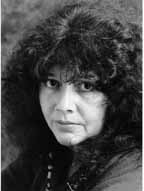 Mumford has a MFA from Brandeis and worked professionally in the theatre. Highly organized she can whip out events and statistics like a gourmet cultural cook. And if you try to get her to talk about her personal achievements, she will change the subject immediately. Although she is endowed with cross-cultural sensitivity, it is Mumford's passion for the collective consciousness of aboriginal peoples that give her words authenticity:
Mumford has a MFA from Brandeis and worked professionally in the theatre. Highly organized she can whip out events and statistics like a gourmet cultural cook. And if you try to get her to talk about her personal achievements, she will change the subject immediately. Although she is endowed with cross-cultural sensitivity, it is Mumford's passion for the collective consciousness of aboriginal peoples that give her words authenticity:
I traveled with traditional grandmothers of the Anishnaabe people. It has been said that the teachings of the Anishnaabe people go back 35 thousand years. The grandmothers were pushing for a vision for the next 7 generations. Why 7 generations? An Anishnaabe teaching. Seven fires, each fire a significant time in history. We are the 7th generation and we need to light the 8th fire. To find our way back to the red road.
In First Nation parlance, when the people are getting ready to move, a "runner" goes out ahead to prepare the selected place to move into. Marjorie Beaueage was the ground breaker for the Aboriginal Arts Project. When Mumford was hired full time in July, '95, the ground work was there and the vision collectively clear. First Nation artists and advisory councils from throughout Canada decided then that it was best to become "multi-disciplinary".
Aboriginal self governance was in place.
Every 3 years, in a cycle of summers, young performers and their respected artistic mentors, develop original dance, theatre, music, and multi-media productions. All based on a variety of aboriginal performance traditions from Canada, the United States and abroad. As Mumford put it, the forms that emerge "affirm trust in Aboriginal process, and a deconstruction and revision of main stream practice"
This is a tough assignment. Student performers may drop by the wayside. Challenged by generational and cross-cultural exchange, and the desire to create new work, performers who stick to it for 3 years, end up staging a culminating production. Summer 2003 was the first addition of the latest three year cycle. It didn't come easy, but it was all there. .
Choreographer Rosalie Jones/Daystar (Blackfeet/Chippewa) jump started the program with a dance work that employed the healing nature of dance into a sustainable expression of spiritual strength and lyricism.
Prayer of The First Dancer: Connecting Circles imagines a time "when there was no dance, no dancers, no reason to dance".
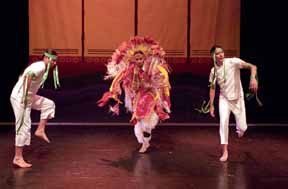 |
Opening with a single performer (Tanya Lukin) in silouhette, raising a hoop to the 4 directions, "Prayer of the First Dancer" rapidly engaged 13 performers with a spirited Navajo Beautyway Chant – narrated by Jones. Simple, eloquent movement developed into evolutionary dance patterns, colorful shawl dancing, fancy dancing, and celebratory pow wow singing. Accompanied by the evanescent heart beat of the drum, the choreography ended with a powerful prayer of reverence. .
At one point a young hip-hop dancer (Paul Campbell), working his way through the steps of hip-hop, broke into a break dance, and then into a free wheeling hoop dance. A magical moment of growth, of finding an unexpected way into cultural roots.
"Prayer For The First Dancer" topped off with a finale of interlocking circles of hoop dancing. Hoops snapping into place like a globe. Like the Earth snapping into place with its myraid of peoples.
Carlos Rivera Martinez's From the Aztlan to the Zocalo is a Mexica (Aztec) work 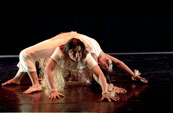 exploring the mystical imagery of the Mexica journey from northwest Mexico to Tenochtitlan – now Mexico City .
exploring the mystical imagery of the Mexica journey from northwest Mexico to Tenochtitlan – now Mexico City .
Huitzilopochtili (Sinister Hummingbird) - Jennifer McLeod in startling face paint and the swift flash of a silvery costume - led the performers in a ritual journey from the known to the unknown – testing their fortitude.
This imaginative and well thought out work evolves through a series of concentrated and layered imagery. (the four directions: earth, wind, fire and water), a variety of dances from the Mexica tradition, and a signal that the journey had ended - an eagle in a cactus eating a serpent. The Mexica had finally arrived at Tenochtitlan. Here they would build a city on water - an architectural marvel of the first order.
The Aboriginal Arts Program has a mandate to assist in the development of indigenous traditional stories only when such a request originates from the tribal source. Columpa C. Bobb (Sto:Lo Salish), director and teacher, came with a 32 page script and requested an opportunity to "workshop" a portion of "Creation – My Mother's Story".
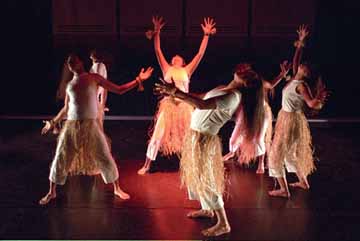 |
The mandate was additionally fulfilled by the mother who appeared in person to pass on Salish traditional thinking about the role of family in "creation" – childbirth and the responsibilities of parents. Composer Russell Wallace's primordial music, with haunting male and female singing voices, provided an embracing atmosphere for the development of the work. Through improvisation with the performers, choreographer Penny Couchie drew from the original source to capture appropriate movement qualities.
Future development will include the masking (in the West Coast tradition) of Sun, Moon, Raven and Moon/Spring, for greater character definition. Columpa Bobb's work promises the opening of new doors in Canadian indigenous theater.
Muriel Miquel (Kuna/Rappahannock) of urban Spider Women fame, a performer of considerable comic achievement, is also a playwright with a powerful message of healing in mind. "She Knew She Was She" is essentially a healing mission. A jingle dress story reshaped into a contemporary psychological context of growth and redemption.
Mortal Woman (Patii Shaughnessy) is unaware of the source of her despair. Surrounded by a "cloud of no seeing", and lacking knowledge of where she is at and how she got there, she is stuck in one place unable to move. Urged on by a trio of spirited singers (The "Kokums", or Grandmothers) – performed by the Edmonton singing group Asani – Mortal Woman is slowly rehabilitated. Lightning Woman (Melody Goodstriker)– a jingle dress dancer with an appropriate dual name – brought positive energy and the power of feminine spiritual intervention to Mortal Woman's dilemna.
The lively performers also contributed a wickedly funny series of short entr'acts between scenes. A wacky salad dressing, thrown in for good measure, balancing outrageous humor with the serious in the best aboriginal tradition.
FILUMENA
Librettist John Murrell is the Artistic Director of the Banff Centre Theatre Arts program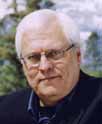 and an internationally recognized Canadian playwright.
and an internationally recognized Canadian playwright.  Along with Calgary composer-in-residence John Estacio, he is also the creative force behind the new opera, Filumena.
Along with Calgary composer-in-residence John Estacio, he is also the creative force behind the new opera, Filumena.
Filumena was inspired by the story of Filomena Costanzo, an Italian immigrant who arrived in Alberta in the early 20th century when she was 9 years old. When she was 15, Filomena's father arranged her marriage to an older man. Her name changed from Costanzo to Sanfide.. She also found herself married to the bootlegging business. When the couple got in trouble with the law, her husband made her change her name again - to Florence Lassandro. Florence Lassandro was one of the last women hanged for murder in Canada. Who pulled the trigger that murdered a constable investigating a bootlegging incident in Alberta in 1922 is the central focus of the work.
John Estacio is a composer influenced by Italian opera, with its rich emotional effects and demands on singers to carry great passions.
"I had listened to some of his music," says Murrell, "and he had read some of my plays. But we had never met before. I tried for 20 years to get together with a composer to write an opera. Opera is a great passion of mine. And I thought, quite likely, that this is my last shot to do it. At that moment the story of Filumena Castanzo sprang into mind. I just spilled my guts and told John, what do you think of this story." Estacio obviously thought well of it. "John and I asked the question that if you were sending a person to see an opera for the first time, an opera virgin, what kind of opera would you send them to see? That if you didn't know a lot of the givens of opera, you nevertheless would understand the heart of the story. And it would work for opera buffs too. The music and words would be accessible and moving".
In her opening aria Filomena (Laura Whalen) yearns for a life "the size of storms".
"Filomena is coming from a place of always being and feeling like an outsider," says Murrell. "For Filomena, storms drive away people's pretensions, scatter the lies that people tell, and clean the air".
Filomena's involvement with the leading male characters Emilio Picariello and his son Stefano fuels the plot into the climax.
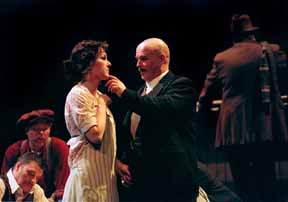 |
"The tie between the elder Picariello and Florence (Filamena) in our opera," says Murrell, "is that they are both "dreamers" who dream of a better life for themselves - more self determination, more independence."
Emilio Picariello (Gaetan Laperriere with a powerful bass voice) is a commanding Robin Hood figure in the Italian community living in the Crowsnest area of Alberta during the Canadian prohibition era. Picariello worked his way up from his former life as a coal miner into the life of an entrepreneur, and fought against the prevailing prejudices towards foreign immigrants at that time. When he got into the bootlegging business, his troubles with the law began. Picariello's son, Stefano (David Pomeroy) marries Filomena for his own purposes. Stefano arranges for his wife to help him cross the border with illegal alcohol between the provinces of Alberta and British Columbia, under the nose of the border guards.
When the elder Picariello is erroneously told that his son Stephano was shot to death by a constable at the border, his rage on hearing the news kicks off the tragedy of Filomena's destiny. Picariello, with Filomena in tow, confronts the constable over the alleged killing of his son. Picariello reaches for his gun. Filomena grabs his hand, the gun goes off, and the constable is shot dead.
The killing of Stefano never occurred, but the killing of the constable did. Picariello and Filomema are condemned to die by the rope around the neck. When Stefano comes to see Filomena in her cell just before the hanging, he pleads for his father's life. Asking her to take the rap for the killing, he is willing to sacrifice his wife's life for the life of his father.
For Filomena this is not the signature of a Solomon's choice. It is the signal of betrayal. Filomena refuses to lie. She who has the most to say about the killing dies without saying it. Once again an immigrant in a storm, she walks to her death courageously.
The opera is site specific. It is song in both English and Italian. The words are projected above the stage and were must helpful during the mix of languages occuring in duet, trio and choral singing. Although I feel it was a distraction that still needs to be worked out.
Filomena is about unfulfilled love, illegal bootlegging, resentment towards foreign immigration, and the betrayal of a woman left taking the rap. It is also about building a province, with all the conflicting emotions of idealism and greed involved.
If you can't afford to visit Banff, go by the light of the Aurora Borealis and get a job there. The setting and the excitement of ideas attracts youth from all over Canada and internationally.
It's well worth the experience.
©2003 Ned Bobkoff
Performance Photos by Donald Lee ©2003 All Rights Reserved
For more commentary and articles by Ned Bobkoff, check the Archives.
 |
from all walks of life in a variety of
cultural and community settings
throughout the United States and abroad
© 2003 AVIAR-DKA Ltd. All rights reserved (including authors' and individual copyrights as indicated). All copyrights, trademarks and servicemarks are protected by the laws of the United States and Internalnational laws. Reproduction in whole or in part without permission is prohibited.
For permissions, contact publishers@scene4.com
All articles are archived on this site.
To access the Archives

OCTOBER 2003
